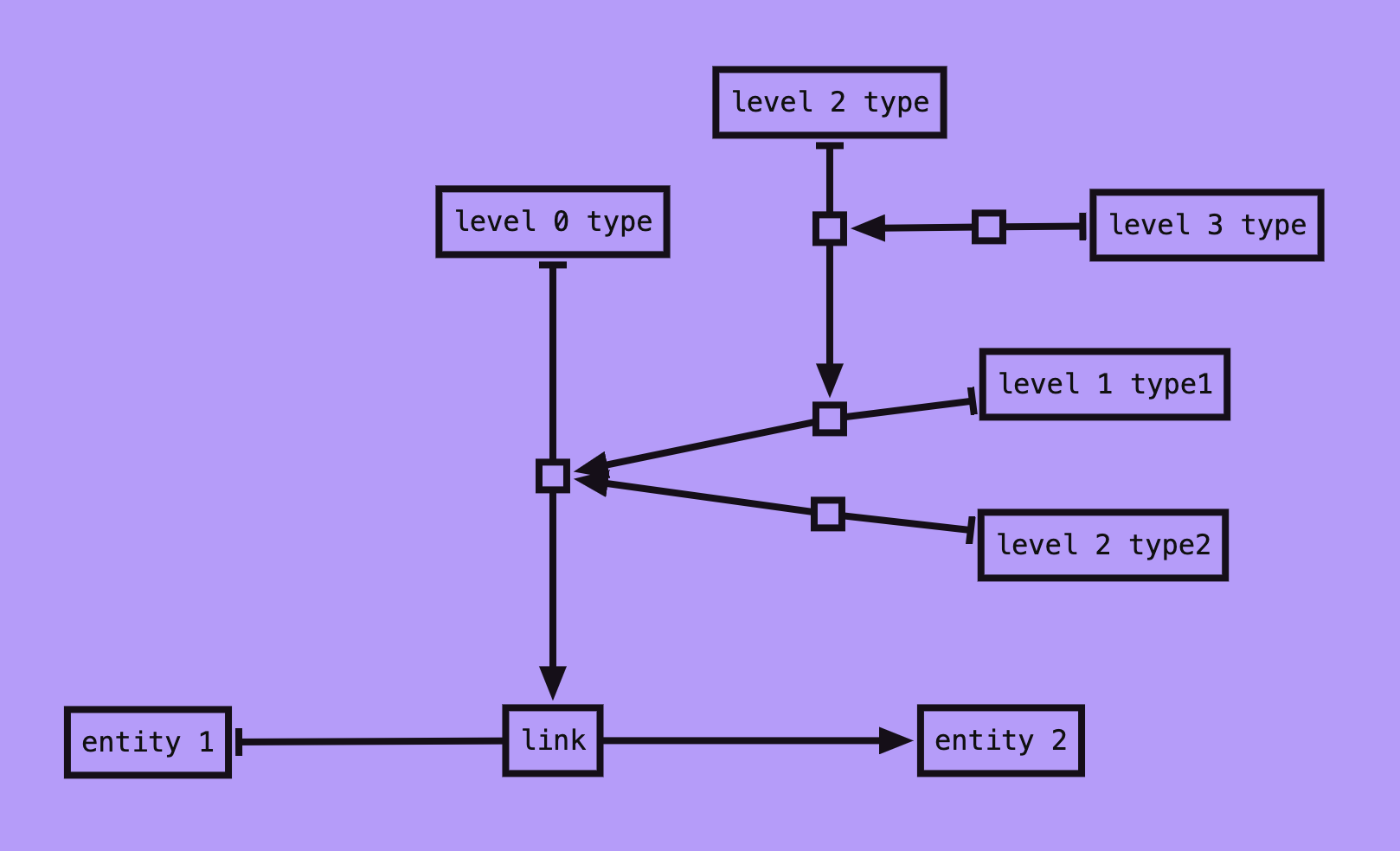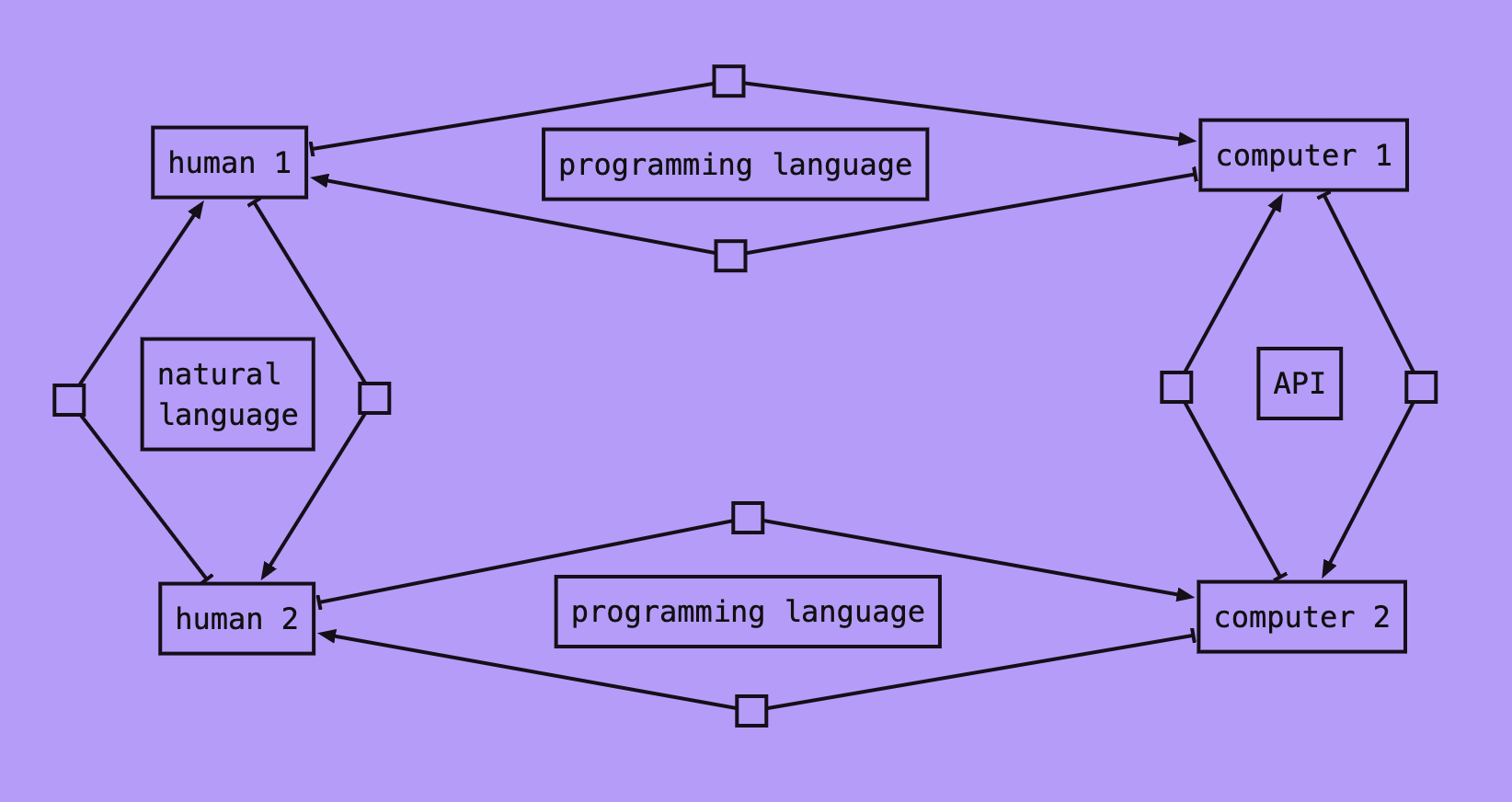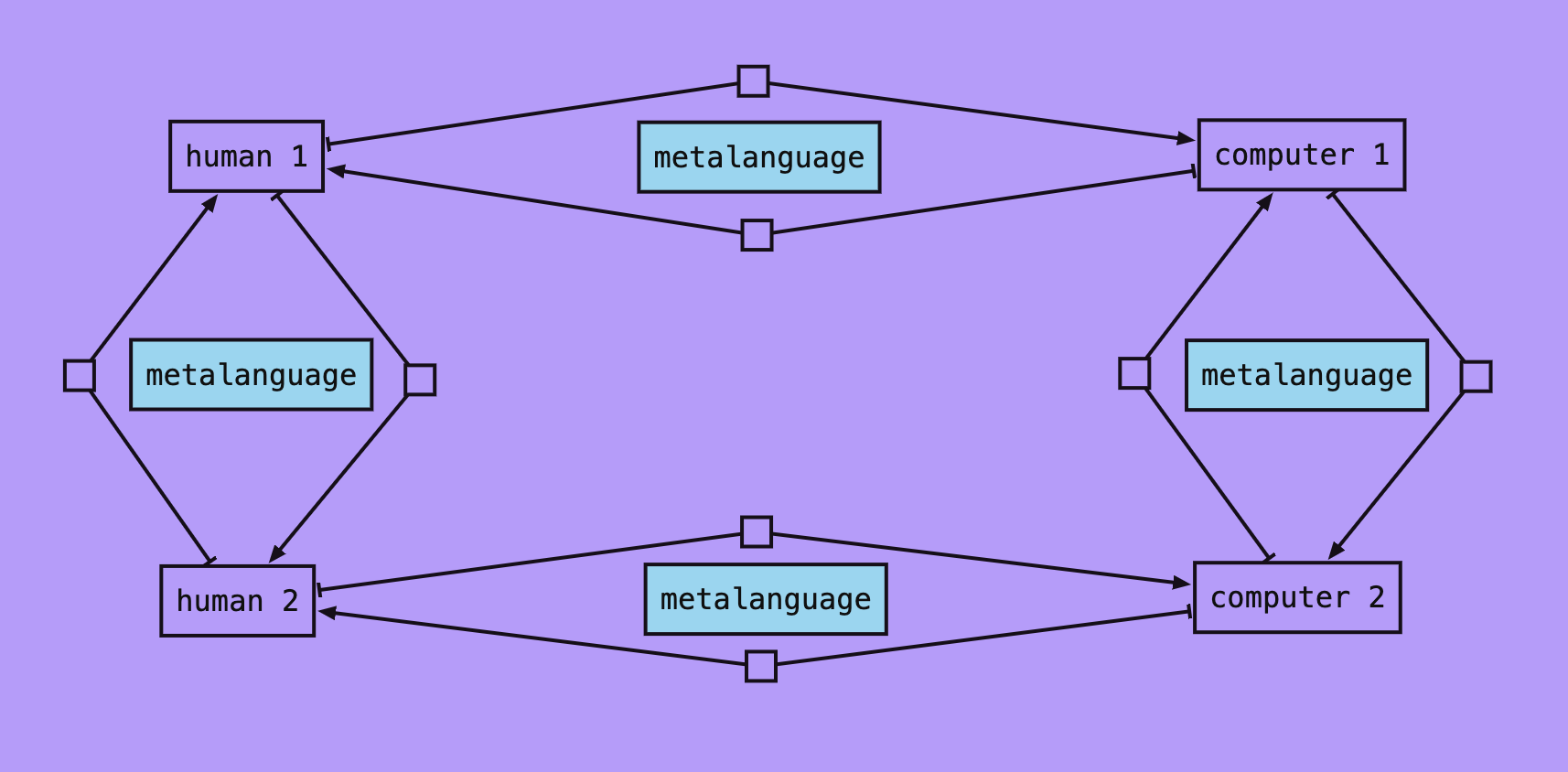is a synthesis of knowledge management and computer science. In this article we give its detailed determination.
Methodology
In general, it is hardly possible to measure knowledge numerically.
But if we consider knowledge in the context of its specific digital representation, we can identify
some basic data structures that can be used to describe knowledge. Their structure and size may well be determined.
Knit
Similar to the bit for measuring information, the knit is the smallest unit of knowledge for a digital device.
According to the postulates of knowledge engineering, a knowledge base can be represented as a set of semantic entities.
According to the practices of computer science, each entity can be designated through a globally unique identifier.
This identifier can then be used as a data structure to describe the knit. The size of the identifier determines the size of the knit.
Let us use uuid v4 for identification,
then the knit values will look like this:
ac2fb456-5936-48dc-934c-1bfcf6bd71e6
8a048d4c-93c0-45b8-8a36-e8a3cd80164d
71076d29-d4ff-430a-b9bd-9c9ee6e5584e
Thus, the size of knit in binary representation = 16 bytes = 128 bits.
Modern uuid standards like uuid v7 are also suitable for knits.
Knyte
Similar to the byte for measuring information, the knyte is the smallest unit of knowledge available to human perception.
If byte is the number of bits needed to encode one character in the text, then knyte is the number of knits needed to fully describe one semantic entity.
node: entity id → knit → uuid v4
initial link: entity id → knit → uuid v4
terminal link: entity id → knit → uuid v4
content: content id → knit → uuid v4
Thus, the size of knyte in binary representation = 4 knits = 64 bytes = 512 bits.
Content Map
is a collection of pairs content id - textual value.
sample content map
ac2fb456-5936-48dc-934c-1bfcf6bd71e6: "first entity"
8a048d4c-93c0-45b8-8a36-e8a3cd80164d: "100500"
71076d29-d4ff-430a-b9bd-9c9ee6e5584e: "link"
Knoxel
Similar to pixel in computer graphics, knoxel is a way to display knyte within a semantic web interface.
sample knoxel

Semantic Web - legacy definition
Starting from 1980s scientists and researchers tryed to find ways to implement Semantic Web.
One of most popular approaches belongs to Tim Berners-Lee.
Back in 2007 he proposed migration from World Wide Web
(also invented by him) to Global Semantic Web
(also known as Giant Global Graph or GGG in short).
Implementation of GGG was supposed to use a bunch of HTML-like languages:
As we can see now, the idea has not been widely adopted.
Semantic Web - modern definition
Using definitions of knit, knyte and knoxel, we can define the semantic web as a collection of
interconnected knytes.
sample semantic web

From knowledge engineering, it is known that human knowledge can be represented as a semantic web - this is the knowledge level, that is, the highest abstraction known to us.
Then, the semantic web can be represented as the graph shown above - this is the information level, that is, a form accessible for interpretation through sensory organs or computer algorithms.
And finally, the semantic graph can be stored in a database, using a well-defined amount of memory - this is the data level, where storage, copying, and transmission of information is implemented.
Let's calculate how many bytes are needed to store the graph shown above. It consists of 13 knytes and 8 content units containing text with a size of (1*4 + 2*8 + 3*12 + 2*13) = 82 bytes.
In total, storing the graph will require (13*64 + 8*16 + 82) = 1042 bytes.
Thus, through this example, we managed to connect the most abstract level of knowledge with the most concrete level of data.
In perspective, this gives us the opportunity to optimize digital communications and implement reasoning artificial intelligence based on existing computer systems for data processing.
Homogeneous Recursive Semantic Graph
Semantic web visualisation shown above is called homogeneous recursive semantic graph.
As classic math graph is designed to visualize node-edge structures from maths,
homogeneous recursive semantic graph is designed to visualize semantic web.
It's homogeneous because consists of one type of elements - knoxels. Knoxel can by node, edge or node
and edge at the same time.
It's recursive because links can link not only nodes, but another links as well.
And it's semantic because every element of the graph represents some knyte, also known as semantic entity.
It's well known in knowledge engineering that any natural language can be represented as a semantic graph.
It's well known in computer sceince that any programming language can be represented as a semantic graph.
If we unite these semantic graphs into one, we will get Metalanguage.
Metalanguage - is a single language for people of all nationalities and computers of all architectures.
Sentence once written in Metalanguage (metasentence) can be automatically translated
to any natural language or to machine code for computer of any architecture.
Metabooks, metasites and metaprogramms may be assembled from metasentences.
Classic communication in modern society

Meta communication in near future

Metalanguage able to replace all APIs (Application Programming Interfaces), natural and programming languages in the field of digital communication.
Examples of Semantic Web
это синтез управления знаниями и компьютерных наук. В этой статье мы даем её детальное определение.
Методология
В общем случае вряд ли возможно измерить знания численно. Но если мы рассмотрим знания в контексте их конкретного цифрового представления, мы можем определить некоторые базовые структуры данных, которые могут быть использованы для описания знаний. Их структура и размер вполне могут быть определены.
knit
Подобно bit'у для измерения информации, knit - это наименьшая единица знания для цифрового устройства. Согласно постулатам инженерии знаний, база знаний может быть представлена как набор семантических сущностей. Согласно практикам компьютерных наук, каждая сущность может быть обозначена через глобально уникальный идентификатор. Этот идентификатор затем может быть использован как структура данных для описания knit'а. Размер идентификатора определяет размер knit'а. Давайте использовать uuid v4 для идентификации, тогда значения knit'а будут выглядеть так:
ac2fb456-5936-48dc-934c-1bfcf6bd71e6
8a048d4c-93c0-45b8-8a36-e8a3cd80164d
71076d29-d4ff-430a-b9bd-9c9ee6e5584e
Таким образом, размер knit'а в двоичном представлении = 16 байт = 128 бит.
Современные стандарты uuid, такие как uuid v7, также подходят для knit'ов.
knyte
Подобно byte'у для измерения информации, knyte - это наименьшая единица знания, доступная для человеческого восприятия. Если byte - это количество bit, необходимых для кодирования одного символа в тексте, то knyte - это количество knit'ов, необходимых для полного описания одной семантической сущности.
узел: идентификатор сущности → knit → uuid v4
начальная связь: идентификатор сущности → knit → uuid v4
конечная связь: идентификатор сущности → knit → uuid v4
контент: идентификатор контента → knit → uuid v4
Таким образом, размер knyte'а в двоичном представлении = 4 knit'а = 64 байта = 512 бит.
Карта контента
это коллекция пар идентификатор контента - текстовое значение.
пример карты контента
ac2fb456-5936-48dc-934c-1bfcf6bd71e6: "first entity"
8a048d4c-93c0-45b8-8a36-e8a3cd80164d: "100500"
71076d29-d4ff-430a-b9bd-9c9ee6e5584e: "link"
knoxel
Подобно pixel'ю в компьютерной графике, knoxel - это способ отображения knyte'а в интерфейсе семантической сети.
пример knoxel'я

Семантическая сеть - классическое определение
Начиная с 1980-х годов ученые и исследователи пытались найти способы реализации Семантической сети. Один из самых популярных подходов принадлежит Тиму Бернерсу-Ли. В 2007 году он предложил переход со Всемирной паутины (также изобретенной им) на Глобальную семантическую сеть (также известную как Гигантский Глобальный Граф или сокращенно GGG). Реализация GGG предполагала использование набора языков, подобных HTML:
Как мы видим сейчас, идея не получила широкого распространения.
Семантическая сеть - современное определение
Используя определения knit'а, knyte'а и knoxel'я, мы можем определить семантическую сеть как коллекцию взаимосвязанных knyte'ов.
пример семантической сети

Из инженерии знаний известно, что доступное человеку знание можно представить в виде семантической сети - это уровень знаний, то есть наивысшая известная нам абстракция.
Далее семантическую сеть можно представить в виде изображенного выше графа - это уровень информации, то есть форма доступная для интерпретации с помощью органов чувств или компьютерных алгоритмов.
И, наконец, семантический граф можно сохранить в базу данных, использовав при этом вполне определённое количество памяти - это уровень данных, на котором реализуется хранение, копирование и передача информации.
Давайте посчитаем сколько байт потребуется для хранения изображенного выше графа. Он состоит из 13 knyte'ов и 8 единиц контента, содержащих текст размером (1*4 + 2*8 + 3*12 + 2*13) = 82 байта.
Итого на хранение графа потребуется (13*64 + 8*16 + 82) = 1042 байта.
Таким образом на примере нам удалось связать самый абстрактный уровень знаний с самым конкретным уровнем данных.
В перспективе это даёт нам возможность оптимизировать цифровые коммуникации и реализовать рассуждающий искуственный интеллект на базе уже существующих компьютерных систем для работы с данными.
Однородный рекурсивный семантический граф
Визуализация семантической сети, показанная выше, называется однородным рекурсивным семантическим графом. Подобно тому как классический математический граф предназначен для визуализации структур узлов и ребер из математики, так же однородный рекурсивный семантический граф предназначен для визуализации семантической сети. Он однороден, потому что состоит из одного типа элементов - knoxel'ей. Knoxel может быть узлом, ребром или узлом и ребром одновременно. Он рекурсивен, потому что связи могут связывать не только узлы, но и другие связи. И он семантический, потому что каждый элемент графа представляет собой knyte, также известный как семантическая сущность.
Из инженерии знаний известно, что любой естественный язык может быть представлен как семантический граф. Из компьютерных наук известно, что любой язык программирования может быть представлен как семантический граф. Если мы объединим эти семантические графы в один, мы получим Метаязык.
Метаязык - это единый язык для коммуникации людей всех национальностей и компьютеров всех архитектур.
Предложение, однажды написанное на Метаязыке (метапредложение), может быть автоматически переведено на любой естественный язык или в машинный код для компьютера любой архитектуры. Метакниги, метасайты и метапрограммы могут быть собраны из метапредложений.
Классическая коммуникация в современном обществе

Метакоммуникация в ближайшем будущем

Метаязык способен заменить все API (интерфейсы программирования приложений), естественные языки и языки программирования в области цифровой коммуникации.
Примеры Семантической сети



